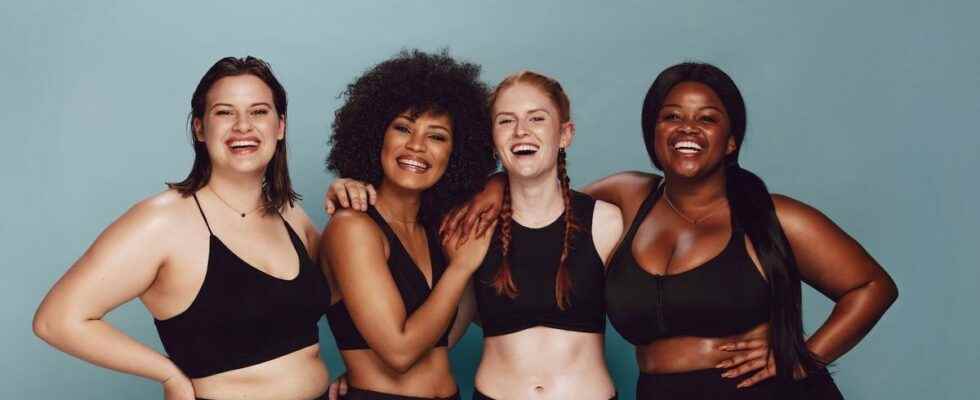Published on
Updated
Reading 5 mins.
Chase away the cult of thinness, it’s coming back at a gallop! The triumph of the body positive movement, which has helped to make fashion (a little) more inclusive, was not enough to send the famous size 0 down. On the contrary, it is even making a remarkable comeback on the catwalks, driven by Y2K and ‘heroine chic’ aesthetics, as well as by the new obsession of certain fashion icons and influencers with displaying a skinny silhouette. Explanations.
In just two seasons, the fashion world has managed to put thinness, if not thinness, back at the center of all attention… Unless the latter has never really left the catwalks. The presence of a greater number of so-called ‘plus size’ models in recent years has – almost – made us forget the omnipresence of size 0 models – corresponding to a 32 in France – which seems to have increased further in recent weeks. of fashion. A phenomenon that is not unrelated to the return of Y2K in fashion, and even less to the (very) slim silhouettes displayed by models and influencers followed by tens of millions of people around the world. Some are already alarmed by the repercussions induced by this potential comeback of the apology of thinness.
A redesigned silhouette
Back in May 2022. On the occasion of the very popular Met Gala, Kim Kardashian shows off in a historic dress worn a few decades earlier by Marilyn Monroe. An exceptional piece in which the reality TV star slipped after losing 7 kilos in just three weeks, as she said herself. A dazzling weight loss that did not fail to trigger the ire of Internet users. “It’s not healthy to lose so much weight in such a short time.“, explained to us Claire Desvaux, dietician and naturopath. Kim K. did not stop there, since she has since displayed, like her sister Khloé, a new silhouette, much thinner. Exit the forms which contributed to the fame of the American, and have inspired many young women, make way for a completely redefined silhouette, and much more skinny.Is the era of the bimbo 2.0 over?Difficult to answer, but it is clear that an injunction always chasing another.
This unexpected event occurred at the very moment when fashion seemed to be on the verge of a major change, with the emergence of a certain diversity on the catwalks. While two fashion giants – Kering and LVMH – signed a charter in 2017 excluding models in size 32 or under the age of 16, the triumph of the body positive movement has seen the appearance in recent years of plus size models both on catwalks and in advertising campaigns. A small revolution in an industry still dominated by a host of injunctions. But these advances could be reduced to nothing – or almost – if they exclude the majority of women, who are neither a size 32 nor a size 50, and even more so if they are stopped by a return to extreme thinness. An observation made during Fashion Week dedicated to the spring-summer 2023 season, organized last September.
The advent of the 2000s
Impossible to miss the phenomenon. During 2021, the Y2Ks have established themselves as the new stars of fashion, returning their letters of nobility to many vestiges of the 2000s: low waist, micro-skirt, visible thong, crop top, and other mini-shorts. Clothing, it must be admitted, reluctant to embrace the very concept of body positivism. Born on social networks, the craze for the Y2K was quick to invest the catwalks, and to ring the great return of size 0. The biggest fashion houses, including Givenchy, Coperni, or Miu Miu , to name a few, have caused a lot of ink to flow for having paraded filiform models, like Bella Hadid or Kaia Gerber, among others. A phenomenon that alerts, and which is not without reminding that inclusiveness is far from being acquired in the fashion industry.
Alexandra Van Houtte, founder of Tagwalk, a fashion search engine, recently confirmed the trend at New York Timesrevealing that “more than half of the fashion shows [dernière] fashion week still did not have any models who were not size 0 or 2”. company manager also specified that the database of the search engine only counted three midsize models to date – whose size is between 42 and 44 – while they represent, among other things, the majority of French women, if the based on the latest national survey campaign organized by the French Institute of Textiles and Clothing (IFTH).
In November 2022, the New York Post highlighted this return to the cult of thinness with an article entitled “Bye-bye booty: Heroin chic is back”. It was then a question of evoking the end of an era, the one praising the prominent buttocks, in favor of another based on a filiform, even skeletal silhouette. Because the term ‘heroine chic’ refers to a grunge aesthetic born in the 90s, referring to models with androgynous looks, pale complexions, and dark circles – and often associated with Kate Moss. An especially controversial aesthetic considering that it has been – and still is – associated with drugs and eating disorders.
An article that made actress and feminist activist Jameela Jamil react: “I am from the generation of the first wave of this phenomenon. We never fully recovered. I lost two decades of my life. I beg you to violently reject this, and to reject any person, magazine or media that participates in spreading this hell.“What a reminder of the consequences that the praise of such aesthetics may have had, and even more of the popularization of any trend that would emphasize one morphology rather than another. Body positivism, otherwise says the acceptance of all human bodies, seems more necessary than ever to shatter the many injunctions that still surround the worlds of fashion and beauty.
